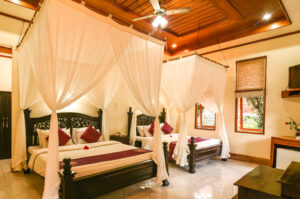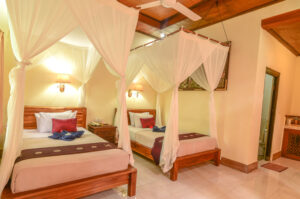
Suite Family
This room is the best we have its two type of bed double or triple bed, has rice field view and garden, furnished by teakwood.
Home » Explore Ubud
MONKEY FOREST
Mandala Suci Wenara Wana, or well known as Ubud Monkey Forest, is the sanctuary and natural habitat of the Balinese long-tailed macaque. It is located at Padangtegal Ubud, Bali. About 1049 monkeys live in this sanctuary. They are divided into 6 groups, namely in front of main temple group, forest conservation group, central point group, eastern group, Michelin group, and cemeteries group. We also divide the monkeys by age: 63 adult male, 34 Sub-adult male, 219 Adult female, 29 Sub-adult female, 167 juveniles 1 (2-3 year), 118 juveniles 2 (1-2 year), 63 Infant old (5-12 month) and 56 infant. Sacred Monkey Forest Ubud is a famous tourist attraction in Ubud. In every month around 10,000–15,000 visitors come to Monkey Forest Ubud. The Monkey Forest Ubud has 186 species of plants and trees in 12,5 hectares of forest. The Monkey Forest Ubud has 3 temples, namely Dalem Agung Padangtegal Temple, Holy Spring Temple and Prajapati Temple. The forest is owned by the Padangtegal community and is managed by Mandala Suci Wenara Wana Management. The purpose of the management is to keep sacred the place and promote the Monkey Forest Ubud as an international tourist destination.[1]
A monkey eating corn at the Monkey Forest
The Monkey Forest lies within the village of Padangtegal, which owns it. The village’s residents view the Monkey Forest as an important spiritual, economic, educational, and conservation center for the village[
UBUD PALACE
The Ubud Palace, officially Puri Saren Agung, is a historical building complex situated in Ubud, Gianyar Regency of Bali, Indonesia
Campuhan river junction
The palace was the official residence of the royal family of Ubud. It was on his travels that Rsi Markandya received a divine revelation that in Bali he was to bury five precious metals on a mountain slope where the mother temple of Besakih now stands today. Along with a group of followers, Rsi Markandya was magnetically attracted to a destination located in the central foothills of the island that radiated light and energy. This place was Campuhan in Ubud at a junction in the Wos River and it was here that he felt compelled to build a temple by the name of Pura Gunung Lebah.
On subsequent expeditions around Bali, Rsi Markandya built a number of other significant temples and created a shared irrigation system for the terraced landscape that is still practiced by farmers today. The formation of the banjar, which is a village council responsible for community and religious affairs, was also inspired by Rsi Markandya. In essence, it can be said that Rsi Markandya is responsible for the foundation of Balinese Hinduism in its purest form referred to as Agama Tirtha or the religion of holy water.
Since being discovered back in the 8th century, the area of Campuhan has always been highly regarded by the Balinese for its immense spiritual powers. Even the term Ubud is derived from the term ubad, meaning medicine in reference to the traditional healing properties of the array of plants that randomly grow here. Generations of Hindu worshippers have made special pilgrimages to the fork in the Wos River to mediate, bathe and collect holy water for temple ceremonies and cleansing rituals.
There had always been ties between Java and Bali, but it was the disintegration of the once mighty Majapahit Empire in the 15th century that saw a mass exodus of nobles to Bali. A new kingdom on the island’s east coast called Gelgel was consequently established and gave sanctuary to many important ruling families. They brought with them an artistic legacy and the principles of the caste system.
By the 17th century Bali invariably experienced a rapid emergence of new kingdoms, including the founding of several royal houses in Ubud. However, this period also saw much conflict between the royal clans with supremacy as the ultimate goal. A prince from Klungkung was sent to create a palace in Sukawati as a centre of great power and aesthetic beauty. Artisans came from all over Bali to help in its construction and once completed many of them chose to stay. Sukawati today is a community that strongly supports all forms of artistry as well as dance and music.
With the successful establishment of a reigning authority in Sukawati, palace retainers were then sent in the late 1700s to secure the area of Ubud. A pair of cousins formed rival communities in Padang Tegal and further north in the area of Taman. Following subsequent fighting between these neighbouring villages the king of Sukawati sent his brothers Tjokorde Ngurah Tabanan to Peliatan and Tjokorde Tangkeban to Sambahan to establish palaces with the notion to control these troubled areas.
UBUD ART MARKET / UBUD TRADITIONAL MARKET IN THE MORNING
The Ubud Art Market is a great place to find beautiful silk scarves, lightweight shirts, statues, kites, handmade woven bags, baskets or hats and many other hand-crafted goods. Locally known as Pasar Seni Ubud, the market is opposite the Puri Saren Royal Ubud Palace and opens daily.
Most of the goods found at the Ubud Market are made in the neighbouring villages of Pengosekan, Tegallalang, Payangan and Peliatan. The location of the Ubud Art Market, which is centred among the art producing villages and at the centre of Ubud itself, makes it a strategic shopping place for Balinese handicrafts and souvenirs.
The Ubud market also served as a setting for the Hollywood movie Eat Pray Love, which shows a scene with actress Julia Roberts opposite a male character strolling through the stalls which are frequently visited by foreign and local visitors in real life. Naturally, bargaining is essential.
TAMAN SARASWATI
The Pura Taman Saraswati is a beautiful water temple in central Ubud. You can access the temple from the Jalan Kajeng side street off the main road of Jalan Raya Ubud. The temple is a great stopover along your leisure walks through Ubud town, where you can admire its classical Balinese temple architecture and enjoy photo opportunities.
Its beautiful foyer features ponds filled with blooming pink lotuses. Most regular visitors drop into Café Lotus for a minimum dinner cover charge, which gets you the best view over the lotuses and to the temple’s open stage. Regular traditional dance performances are held in the evenings here from 7.30pm.
CAMPUHAN RIDGE WALK
Ubud’s jungle-like greenery, deep valleys, trickling rivers, and wooden chalets are best admired from Campuhan Ridge Walk, a 1.7-kilometer-long (1-mile) trail. The meandering path provides an escape from the tooting horns and persistent market sellers of central Ubud as you ascend to a slice of nature above the town.
The walk is inclusive for all fitness levels, with the most difficult section being the steep steps up the Wos river valley to the southern end of the ridge. The biggest challenge from there is the heat of the sun as you wander along the softly inclining ridge at your own pace.
The trail winds above two jungle-filled valleys as the East and West Wos rivers rush towards their confluence with the Cerik River, below the start of the trail. Occasional glimpses of rice fields and homestays in the distance add to the peaceful ambiance.
At the northern end of the ridge, trail-goers reach the quaint semi-urbanized village of Bangkiang Sidem, where the path is straddled by warungs, cafes, fragrant day spas, and homestays. Local artists display drawings and paintings of Balinese culture and landscapes in small galleries or even on the side of the path.
SUBAK JUWUK MANIS RICE FIELD TREKKING
Subak Juwuk Manis (also known as Magical Rice Fields in Ubud) is one of the few hidden Bali rice fields in Ubud! Since the path is not accessible by car or scooter, the walk feels more peaceful and you also won’t encounter many people there.
These rice fields are magical indeed with their incredible green hue and the narrow path lined with coconut trees offers great photo opportunities! Subak Juwuk Manis is, in my opinion, the best rice fields walk in Ubud!
MUSEUM :
– MUSEUM RATNA WARTA
– MUSEUM BLANCO
– MUSEUM NEKA
– ARMA MUSEUM

This room is the best we have its two type of bed double or triple bed, has rice field view and garden, furnished by teakwood.

Same like standard room, we also have room with Fan and air Conditioning. Our room with Fan is a Triple bed room (double + single

We have 2 different of standard, with fan and Air Conditioning. Our room with fan we have twin/double bed and also have room for family
WhatsApp us